On my way to the newly opened Taiwan Literature Base (台灣文學基地), I began noticing the numerous similarly styled black-tile Japanese houses in the area.
Scattered across the alleys between Huashan 1914 Creative Park and Chiang Kai-shek Memorial Hall, a few structures have been immaculately restored and opened to the public, but many more were crumbling behind construction fences or sitting solemnly behind concrete walls guarded by barbed wire and bottle shards.
After the Japanese demolished the old Taipei city walls during the first 10 years of their rule, they designated the area directly east of the old city for dormitories to house public servants and officials. Some were used by the Chinese Nationalist Party (KMT) personnel after the Japanese left, but eventually most of them fell into disarray and many were demolished.
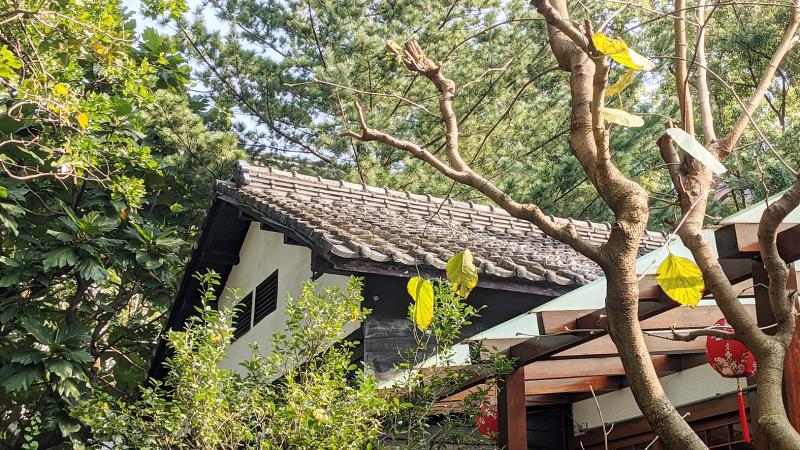
Photo: Han Cheung, Taipei Times
The Literature Base is considered the best-preserved cluster in Taipei, but it took a great effort by residents, activists and experts in the early 2000s to prevent its destruction — more will be written on this in a feature next week. Between my interviews, I began exploring the area, which makes up a tranquil slice of Taipei where history persists against development, and curious relics like the Republic of China (ROC) Abacus Institute (中華民國珠算學會) and the Hua Chiao Night Club (華僑大舞廳), both over half a century old, are still open.
It shouldn’t take more than a few hours to explore the neighborhood, making it an ideal afternoon or morning stroll.
HOME TO THE ARTS
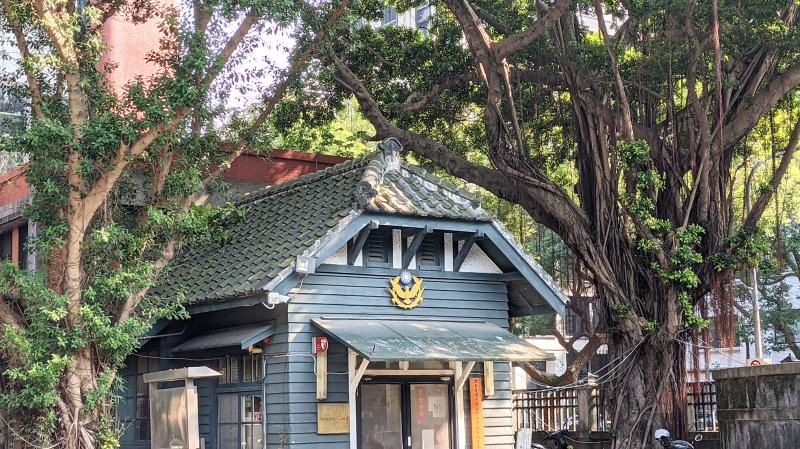
Photo: Han Cheung, Taipei Times
Start from the intersection of Qidong Street (齊東街) at Jinshan South Road (金山南路), right across the street from the immensely popular front lawn of Huashan Creative Park. The curved path, atypical for Japanese urban planning, was part of a Qing Dynasty throughway used to transport goods from the city center to the Xikou wharf (錫口) near today’s Songshan Train Station.
Sun Chi-jung (孫啟榕), an architect involved in the protection and restoration of several buildings in the area, directs my attention to a small square of red brick on one of the facades with the silhouette of a traditional Taiwanese roof still visible on the side wall. That’s the only remnant of the street’s Qing history, Sun says.
The restored Japanese dormitories are immediately visible from here. After the war, these ones were used as residences for Bank of Taiwan officials. Restored by Sun, the two preserved houses to the north are now the Taipei Painting and Calligraphy Garden (台北書畫院) and the Taipei Qin Hall (台北琴道館), which, like the Literature Base, are dedicated to promoting traditional arts.
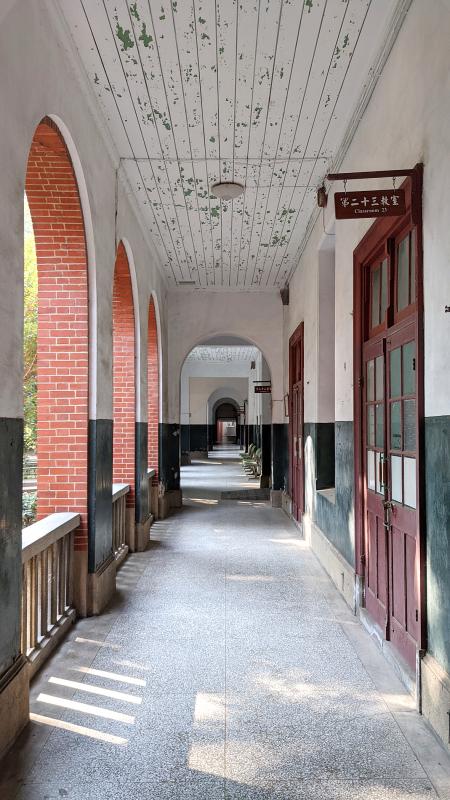
Photo: Han Cheung, Taipei Times
Sun first restored Taiwan Literature Base’s main building as the Qidong Poetry Salon (齊東詩社) before the rest of the seven-house complex surrounding a picturesque courtyard opened to the public last month. Hang out in the gardens, see the exhibitions (not all of them have English, unfortunately) and soak in the atmosphere.
An optional detour from here is to cross Jinshan South Road and head down Linyi Street Lane 14 (臨沂街14巷) to Chapter (文房), where a plain but imposing enclosing wall shelters a beautifully restored Japanese dorm-turned-library. Reservations are required to enter with a limit of 15 people per two hour time slot on weekdays and 20 on weekends, but you can stroll through the garden and get a peek at the classy interior.
WHERE THE BIGWIGS LIVED
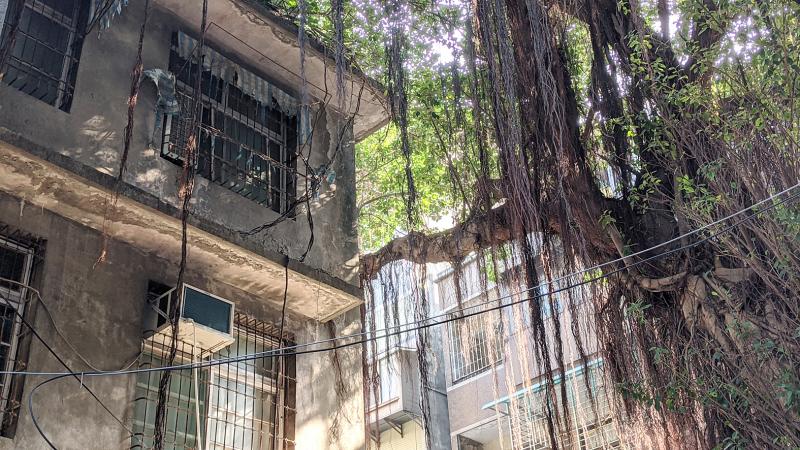
Photo: Han Cheung, Taipei Times
Head back to the Literature Base, where right across the street is the former residence of Sun Yun-Hsuan (孫運璿), who served as ministers of transportation and economic affairs, as well as premier, between 1967 and 1984. During the Japanese era, it housed the Taipei director of Mitsubishi and is currently the official residence of the vice premier.
One alley south is a row of dilapidated, similarly styled houses protected by scaffolding and construction fencing. The sign on the fence reads “Navy Officer Dormitory Emergency Rescue Project,” as it fell into disarray after once housing illustrated generals such as former deputy minister of defense Ma Chi-chuang (馬紀壯) and Ni Yue-si (黎玉璽), who served as the ROC Army’s chief of general staff. In November of last year, Taipei City Government revealed plans to turn it into an experimental elementary school.
Less than a block to the east on Taian Street Lane 2 (泰安街2巷) is Li Kwoh-ting’s Residence (李國鼎故居), a wooden structure painted a tasteful light green with a colorful flower bed in front. This man is so revered that he’s been dubbed both the “Father of Taiwan’s Economic Miracle” and the nation’s “Godfather of Technology.” He also has an asteroid named after him.
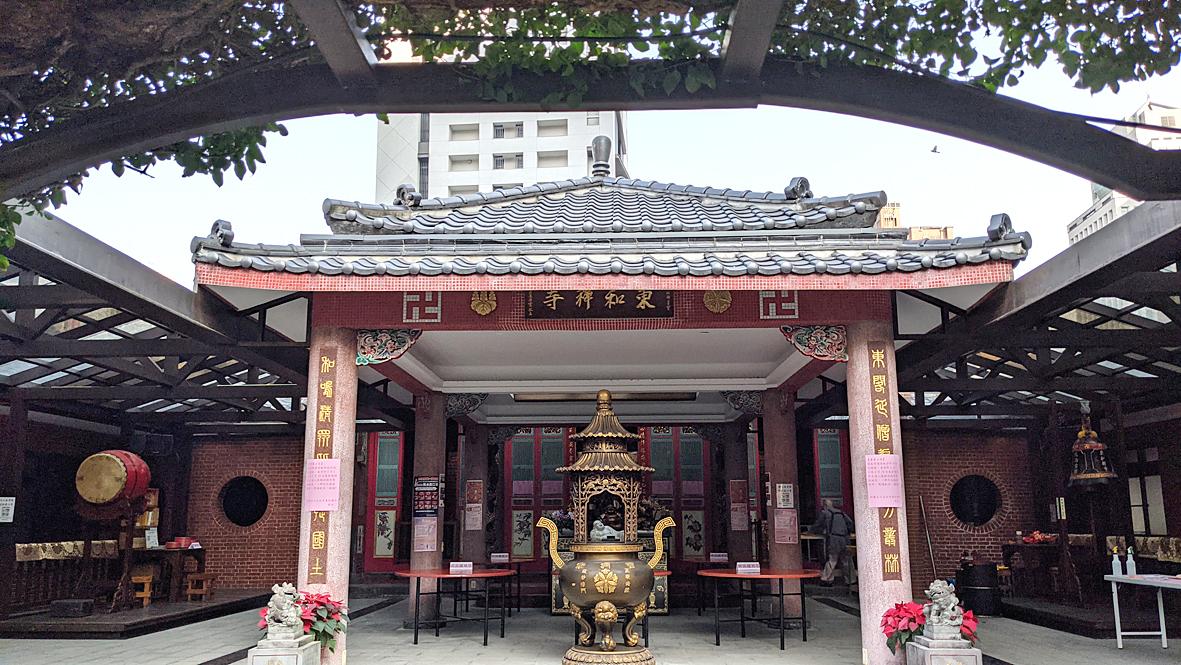
Photo: Han Cheung, Taipei Times
Keep heading east to find a magnificent banyan tree towering over a dilapidated apartment building; then head south to find another Japanese-style residence on Tongshan Street (銅山街), a former National Taiwan University (NTU) dormitory.
HEADING WESTWARD
If you’re not tired of those black-tiled roofs yet, continue west on Tongshan Street, cross Hangzhou South Road (杭州南路) to find the grounds of the former Taihoku (old name for Taipei) School of Commerce, where a charming wooden Japanese-style guardhouse with a rare “jerkinhead” roof style is visible from the street. It ceased to function as campus grounds only in 2015, but it feels that nobody has been here in decades. The arched halls of the red-brick main building has an eerie feel reminiscent of the White Terror-era horror movie Detention (返校), and some of the classrooms even resemble those in the movie, with heaps of chairs and tables piled on top of each other.
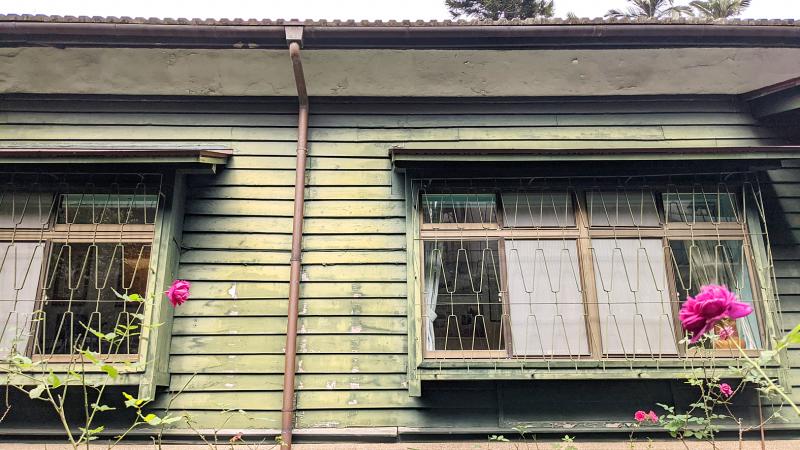
Photo: Han Cheung, Taipei Times
Across the street is the Mayor’s Residence Art Salon (市長官邸藝術沙龍), which was built in 1940 for Japanese officials and housed every post-war mayor of Taipei up until 1994. Today the expansive courtyard is dotted with modern sculptures and the structure functions as a gallery, restaurant and event space.
On the south side of Renai Road (仁愛路) between Shaoxing South Road (紹興南路) and Linsen South Road (林森南路) is a strange grid of overgrown fields, remnants of razed brick buildings and a few Japanese dorms that still stand. The stickers and signs that remain indicate an intense battle between the residents and the city and NTU, and it seems like the officials won. One of the surviving Japanese houses belonged to Lee Chen-yuan (李振源), a pharmacologist famous for his research on snake venom.
To wrap up the trip, head back across Renai Road to find an exquisite bell tower built in 1930 at the original entrance to a massive Zen Buddhism complex. Decades of urban renewal and illegal occupation chipped away at the complex, and only the main hall remains as the Donghe Zen Temple (東和禪寺), which is wedged between a large building and a tiny alley but still retains a small side-lawn with a stone path.
I’ve passed by the bell tower numerous times over many years, but had no idea that there was such an undisturbed space hidden here. Those who live in the capital often take our daily commutes for granted and shuttle out of town whenever we can, but apparently there’s still much exploration to be done.

Oct. 27 to Nov. 2 Over a breakfast of soymilk and fried dough costing less than NT$400, seven officials and engineers agreed on a NT$400 million plan — unaware that it would mark the beginning of Taiwan’s semiconductor empire. It was a cold February morning in 1974. Gathered at the unassuming shop were Economics minister Sun Yun-hsuan (孫運璿), director-general of Transportation and Communications Kao Yu-shu (高玉樹), Industrial Technology Research Institute (ITRI) president Wang Chao-chen (王兆振), Telecommunications Laboratories director Kang Pao-huang (康寶煌), Executive Yuan secretary-general Fei Hua (費驊), director-general of Telecommunications Fang Hsien-chi (方賢齊) and Radio Corporation of America (RCA) Laboratories director Pan
The consensus on the Chinese Nationalist Party (KMT) chair race is that Cheng Li-wun (鄭麗文) ran a populist, ideological back-to-basics campaign and soundly defeated former Taipei mayor Hau Lung-bin (郝龍斌), the candidate backed by the big institutional players. Cheng tapped into a wave of popular enthusiasm within the KMT, while the institutional players’ get-out-the-vote abilities fell flat, suggesting their power has weakened significantly. Yet, a closer look at the race paints a more complicated picture, raising questions about some analysts’ conclusions, including my own. TURNOUT Here is a surprising statistic: Turnout was 130,678, or 39.46 percent of the 331,145 eligible party

The classic warmth of a good old-fashioned izakaya beckons you in, all cozy nooks and dark wood finishes, as tables order a third round and waiters sling tapas-sized bites and assorted — sometimes unidentifiable — skewered meats. But there’s a romantic hush about this Ximending (西門町) hotspot, with cocktails savored, plating elegant and never rushed and daters and diners lit by candlelight and chandelier. Each chair is mismatched and the assorted tables appear to be the fanciest picks from a nearby flea market. A naked sewing mannequin stands in a dimly lit corner, adorned with antique mirrors and draped foliage

The election of Cheng Li-wun (鄭麗文) as chair of the Chinese Nationalist Party (KMT) marked a triumphant return of pride in the “Chinese” in the party name. Cheng wants Taiwanese to be proud to call themselves Chinese again. The unambiguous winner was a return to the KMT ideology that formed in the early 2000s under then chairman Lien Chan (連戰) and president Ma Ying-jeou (馬英九) put into practice as far as he could, until ultimately thwarted by hundreds of thousands of protestors thronging the streets in what became known as the Sunflower movement in 2014. Cheng is an unambiguous Chinese ethnonationalist,